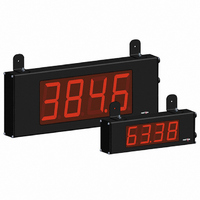LD200600 Red Lion Controls, LD200600 Datasheet - Page 9

LD200600
Manufacturer Part Number
LD200600
Description
COUNTER 6 DIGIT 2.25" 120VAC RED
Manufacturer
Red Lion Controls
Series
LDr
Datasheet
1.LD200400.pdf
(16 pages)
Specifications of LD200600
Count Rate
35kHz
Number Of Digits/alpha
6
Input Type
Voltage, Switch Closure, Transistor Switch
Voltage - Supply
11 V ~ 16 VDC, 85 V ~ 250 VAC
Display Type
LED Red
No. Of Digits / Alpha
6
Digit Height
57mm
Power Consumption
26VA
Counting Speed
25kHz
Operating Temperature Range
0°C To +50°C
Signal Input Type
Pulse
Character Size
2.25"
Ip/nema Rating
IP65 / NEMA 4X
Counter Supply Voltage
85-250VAC/11-16VDC
Rohs Compliant
Yes
Lead Free Status / RoHS Status
Lead free / RoHS Compliant
Output Type
-
Lead Free Status / RoHS Status
Lead free / RoHS Compliant, Lead free / RoHS Compliant
assigned to these displays. This parameter does not affect rate scaling calculations.
Key-in Style:
in pulses per second (Hz).*
Apply Style:
press
input signal to Input A. Press
appear on the display. To insure the correct reading, wait several rate sample
periods (see Rate Low Update Time) or until a consistent reading is displayed.
Press
Enable should be set to
parameters are not accessible.
known, the Key-in (
without the presence of a rate input signal.
Apply (
entered using the front panel buttons for either Scaling Style.*
*For value entry instructions, refer to selection/value entry in the Programming
5.2 MODULE 2 - R
This selects the decimal point position for rate displays and any setpoint value
Enter the Rate Input value using the front panel buttons. This value is always
The meter initially shows the stored Rate Input value. To retain this value,
This parameter enables the rate display. For maximum input frequency, Rate
If a Rate Input value (in Hz) and the corresponding Rate Display value are
If the Rate Input value has to be derived from the actual rate input signal, the
Enter the desired Rate Display value for the Scaling Point. This value is
Enter the corresponding Rate Input value using the Scaling Style selected. *
The Meter section.
PAR
PAR
PAR
Enable
Rate
to advance to the next parameter. To enter a new value, apply the rate
to store the displayed value as the new Rate Input value.
) Scaling Style should be used.
RATE SCALING DISPLAY VALUE
RATE INPUT SCALING STYLE
RATE SCALING INPUT VALUE
RATE DECIMAL POINT
) Scaling Style can be used. This allows rate scaling
Rate Decimal
when not in use. When set to
RST
RATE ENABLE
Point
to
to
and the applied input frequency (in Hz) will
Scaling Style
Rate Input
ATE
, the remaining rate
S
PARAMETER MENU
ETUP
Display Value
Rate Scaling
P
9
ARAMETERS
SCALING FOR RATE INDICATION
Input value. These values are internally plotted to a Display value of 0 and Input
value of 0.0 Hz. A linear relationship is formed between these points to yield a
rate display value that corresponds to the incoming input signal rate. The meter
is capable of showing a rate display value for any positive slope linear process.
SCALING CALCULATION FOR KEY-IN STYLE
those values can be entered into Scaling Display (
(
known, then it can be entered as the Scaling Input value and the Scaling Display
value will be entered as the following:
NOTES:
EXAMPLE:
updates for the Rate display. Values of 0.1 and 0.2 seconds will update the
display correctly but may cause the display to appear unsteady.
display is forced to zero. (For more explanation, refer to Rate Value
Calculation.) The High Update Time must be higher than the Low Update Time
and higher than the desired slowest readable speed (one divided by pulses per
second). The factory setting of 2.0, will force the display to zero for speeds
below 0.5 Hz or a pulse every 2 seconds.
Rate Scaling
Input Value
To scale the Rate, enter a Scaling Display value with a corresponding Scaling
If a display value versus input signal (in pulses per second) is known, then
If only the number of pulses per ‘single’ unit (i.e. # of pulses per foot) is
1. If # of pulses per unit is less than 1, then multiply both Input and Display
2. If the Display value is raised or lowered, then Input value must be raised
3. Both values must be greater than 0.
1. With 15.1 pulses per foot, show feet per minute in tenths. Scaling Display
2. With 0.25 pulses per gallon, show whole gallons per hour. (To have greater
The Low Update Time is the minimum amount of time between display
The High Update Time is the maximum amount of time before the Rate
values by 10 or 100 as needed for greater accuracy.
or lowered by the same proportion (i.e. Display value for per hour is
entered by a third less (1200) then Input value is a third less of # of pulses
per unit). The same is true if the Input value is raised or lowered, then
Display value must be raised or lowered by the same proportion.
= 60.0 Scaling Input = 15.1.
accuracy, multiply both Input and Display values by 10.) Scaling Display
= 36000 Scaling Input = 2.5.
). No further calculations are needed.
RATE LOW UPDATE TIME (DISPLAY UPDATE)
RATE PER
RATE HIGH UPDATE TIME (DISPLAY ZERO)
Second
Minute
Hour
Update Time
Rate Low
(
DISPLAY (
to
to
3600
60
1
Update Time
Rate High
)
seconds
seconds
)
# of pulses per unit
# of pulses per unit
# of pulses per unit
INPUT (
) and Scaling Input
)










